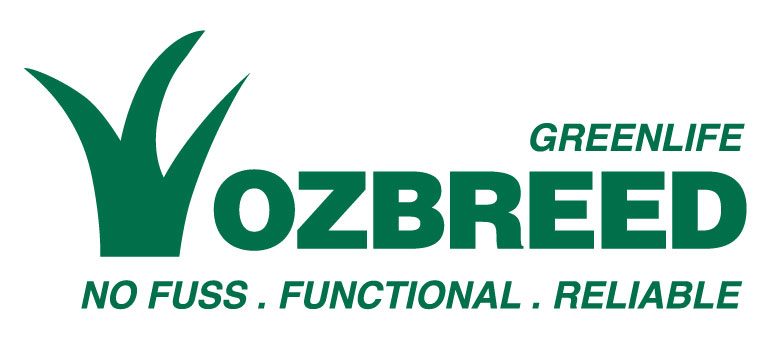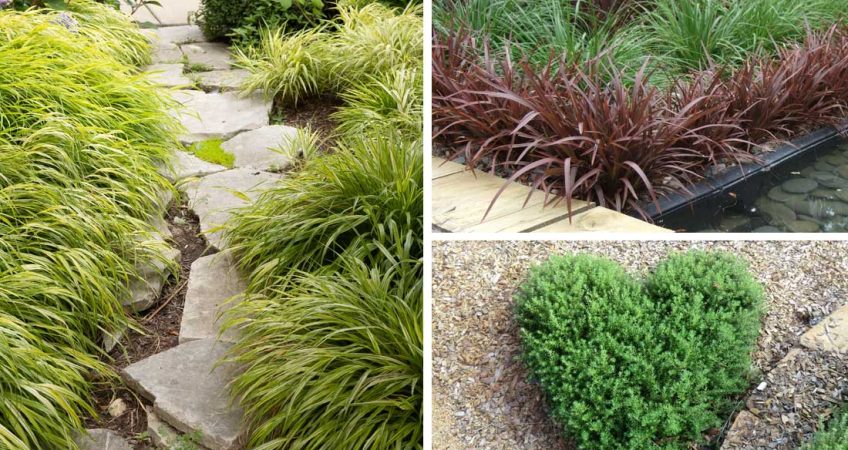Have you ever wondered how to enhance the beauty and functionality of your pathed areas with plants? Have you considered lining pathway borders with low-growing varieties that provide structure and clarity within your garden’s design?
Integrating vegetation around pathways not only adds aesthetic value but also improves environmental benefits. However, choosing the right plants can be a complex task requiring careful consideration of several factors. In this article, we will delve into the essential aspects to consider when specifying plants for around pathways and pavers, ensuring your garden thrives and looks stunning year-round.
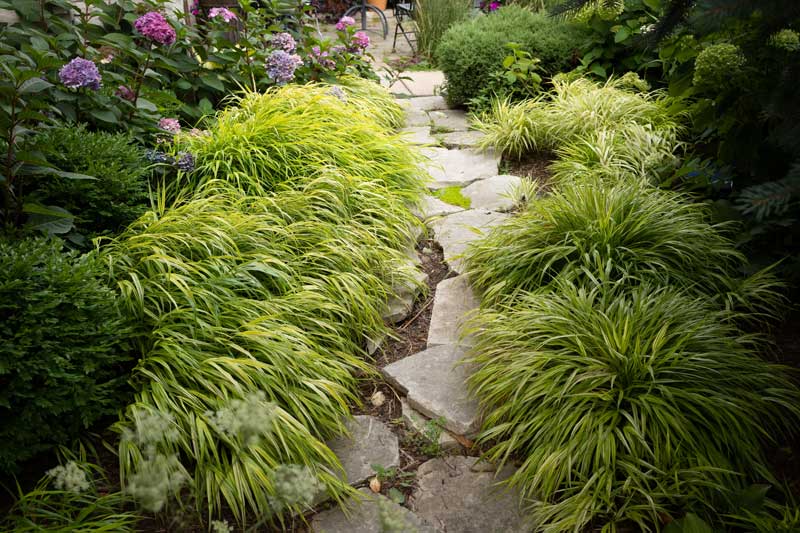
This pathway would look boring without the plants lining its borders, which soften the edges and lead the eye. https://www.shutterstock.com/image-photo/limestone-path-separates-borders-hakonechloa-macra-2256684633
Climate Suitability
Temperature Tolerance
Consider the temperature variations throughout the year. Choose plants that can withstand both the summer heat and winter cold in your area.
Weather Tolerance
Of course, temperature is only one part of climate suitability. Consider the humidity, any coastal salt that will be relevant, and the amounts of rain you expect over the next few decades.
Micro Climate
How do the conditions change within your garden? Depressed, shady areas of the garden will be more hospitable to some plants, whereas raised sunny positions will be better suited for other types of plants.
Light Requirements
Sun Exposure
Assess the amount of sunlight the area receives. For full sun areas, opt for sun-loving plants like phormium and westringia. For shaded spots, consider shade-tolerant options such as liriope and certain dianellas which can both tolerate full sun and heavy shade.
Watering Needs
Drought Tolerance
If the area is prone to dry spells, select drought-tolerant species like westringia or lomandra. These plants require minimal watering and can thrive in less fertile conditions.
Moisture Preferences
Ensure the plants’ watering needs match the site’s moisture conditions. For consistently damp areas, choose moisture-loving plants like certain callistemons.
Soil Conditions
Soil Type
Evaluate the soil type present around the pathway or pavers. Sandy, loamy, or clay soils all have different characteristics, and the selected plants should be well-suited to these conditions. Alternatively, you can amend heavy clay soils with organic matter and/or gypsum and/or quality water crystals. On the other hand, you can amend light sandy soils with organic matter, and/or quality water crystals, and/or kaolin clay.
Soil pH
Test the soil pH and select plants accordingly. Most plants prefer neutral to slightly acidic soils, but some species thrive in more specific pH ranges.
Growth Habit and Size
Mature Size
Consider the mature height and spread of the plants to prevent overcrowding. Low-growing plants are ideal for between pavers as they stay compact and don’t obstruct the pathway. On the other hand, you may wish for a slightly taller plant to line the borders of pathways, depending on the space and your design preferences.
Growth Rate
Choose plants with a growth rate that suits your maintenance preferences. Fast-growing species might require more frequent trimming, while slow-growers are generally lower maintenance.
Maintenance Requirements
Pruning Needs
Select low-maintenance plants if minimal upkeep is desired. This is particularly important for large paved areas where regular maintenance can become cumbersome. If you’d rather plant smaller specimens that will grow quickly to the desired size, just know that there will be more regular pruning required after they’ve reached the desired size.
Fertilisation
Take into account the fertilisation needs of the plants. Some plants may require regular feeding to maintain their health and appearance, while others thrive on neglect.
Traffic Tolerance
Foot Traffic
If relevant, ensure the plants can withstand the level of foot traffic in the area. For heavily trafficked zones, choose hardy species like creeping thyme that can recover from occasional trampling.
Resilience
Opt for resilient plants that can endure physical disturbances. This is especially crucial for spaces frequently used by children or pets.
Aesthetic Appeal
Colour
Consider the bloom colours and how they complement the surrounding hardscape. Mix and match colours to create visual interest and harmony. Consider how the colours change throughout the seasons.
Texture
Incorporate different textures to enhance the visual appeal. The combination of fine and coarse-textured plants can add depth and richness to the design.
Seasonal Interest
Select plants that offer year-round appeal. Evergreen foliage or seasonal blooms ensure that the area remains attractive throughout the seasons.
Ecological Impact
Native Species vs Exotic Species
Prioritise native or well-adapted species to promote local biodiversity. Native plants are great, but don’t forget about exotic plants which have a lot to offer as well. In urban areas, resources for generalist pollinators are always most welcome whether they’re native or not.
Pollinator-Friendly
Choose plants that support pollinators like native bees and butterflies. Providing a variety of different flower shapes, colours, and amounts of pollen and nectar is a good idea. While it’s possible to study individual relationships between certain pollinators and their flower preferences, simply providing a wide variety of different plants and keeping them quite dense and bountiful gives us the best “bang for buck” rather than getting stuck in the belief that we have to understand every ecological interaction.
Habitat
It’s easy to overlook the role a simple garden border can play in creating habitat, but you’d be surprised. Native skinks, insects and other vertebrates and invertebrates can make their homes amongst the throng of small plants, often venturing onto pavers to sun themselves and hunt for pests to feed upon.
Compatibility with Pavers
Root System
Opt for plants with non-invasive root systems to prevent damage to pathways and pavers. Avoid species known for aggressive root growth which can undermine the stability of the paving.
Spacing
Ensure adequate spacing between pavers to accommodate the selected plants. Proper spacing allows roots to grow without constriction and helps prevent overcrowding.
5 Plants for Lining Borders Around Pathways and Paved Areas
Let’s go over 5 plants that are perfect for lining borders and paved areas.
Sweet Mist™ Phormium tenax ‘PHOS2’ PVR
Sweet Mist™ Phormium is an ultra-compact, New Zealand native plant with striking bronze foliage. This NZ flax adds an exciting contrast to modern garden landscapes and is particularly suitable for low borders, mass plantings, containers, and patio pots.
Size
Sweet Mist™ Phormium grows to a height of 40 cm and spreads 40 cm wide. Its compact size makes it ideal for lining pathways without obstructing visibility.
Climate Tolerance and Care
This plant thrives in full sun to partly shaded areas and tolerates frost and moderate dry conditions. It can adapt to various soil types but prefers free-draining soil. It’s suitable to climates on both the South and North islands of NZ, including coastal positions. Water well for the first 8-13 weeks while the plant establishes.
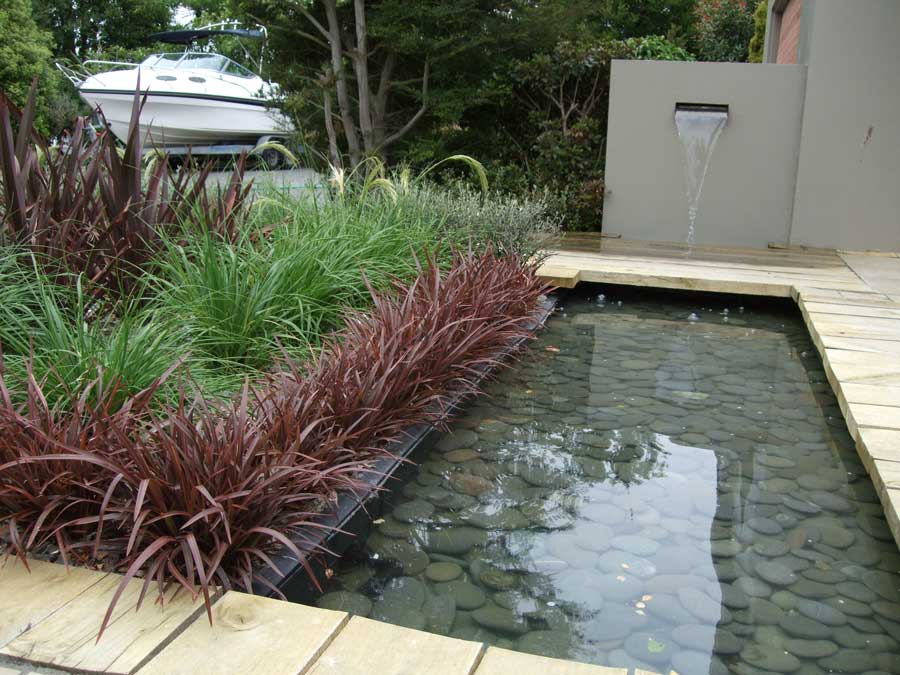
https://ozbreed.co.nz/plant-ranges/strappy-leaf-plants/sweet-mist-phormium/
Low Horizon™ Westringia fruticosa ‘WES06’ PVR
Low Horizon™ Westringia is a dense, ultra-compact ground cover with shorter internodes and a flat growth habit. It is one of the lowest maintenance Westringias available; you don’t ever need to prune it but it does benefit from occasional pruning to maintain its tight appearance, especially if you wish to keep a tight line against a pathway or paved area.
Size
This plant grows to 30 cm high and spreads 70 cm wide. Planting density is 2-3 plants per square metre or per linear metre.
Climate Tolerance and Care
Low Horizon™ Westringia thrives in full sun to part shade and suits sandy to well-drained clay soils. It tolerates cold and drought conditions. Regular watering is needed for the first 8-13 weeks until established. It is suitable for both North and South Islands.
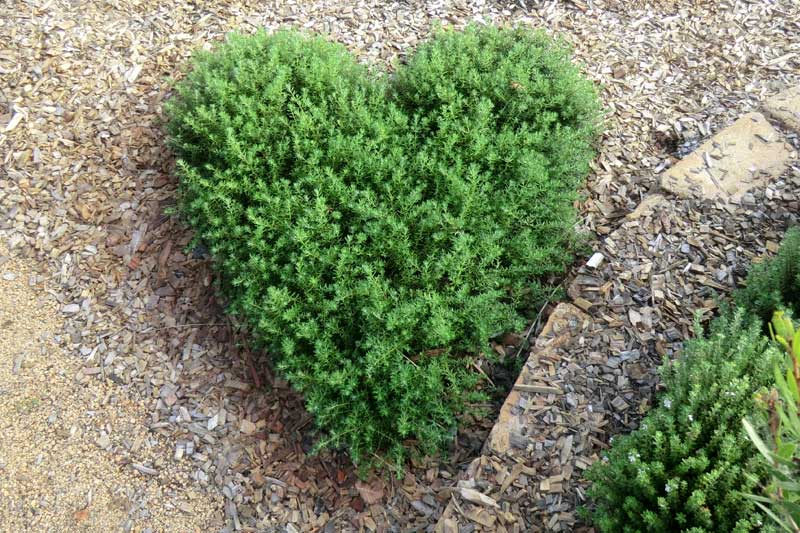
https://ozbreed.co.nz/plant-ranges/shrubs-and-ground-covers/low-horizon-westringia/
Baby Bliss™ Dianella revoluta ‘DTN03’
Baby Bliss™ Dianella is a striking Australian blue flax lily ideal for garden borders and low growing ground cover. It is well-suited to both home and commercial landscapes, and softens straight lines with its strappy foliage.
Size
This compact plant reaches 30 cm in height and width. The recommended planting density is 6-12 plants per square metre or 3-6 plants per linear metre.
Climate Tolerance and Care
Baby Bliss™ Dianella tolerates a diverse range of climates, thriving in full sun to part shade. It is very hardy with excellent drought and frost tolerance. It is suitable for most parts of New Zealand, especially non-humid regions. Regular watering is needed for 8-13 weeks until established.
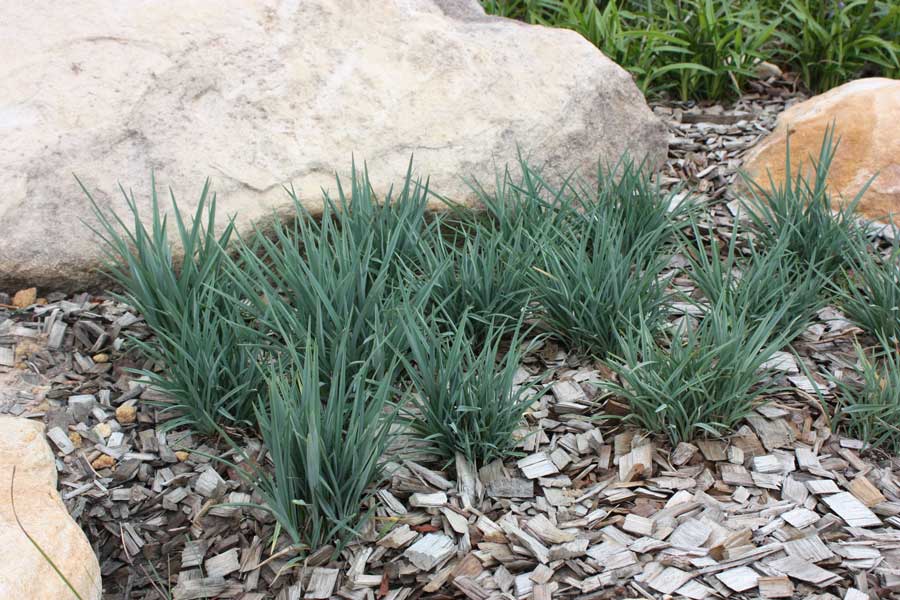
https://ozbreed.co.nz/plant-ranges/strappy-leaf-plants/baby-bliss-dianella/
Obsession™ Nandina domestica ‘SEIKA’ PVR
Obsession™ Nandina is an improved selection of the dwarf Nandina ‘Gulf Stream’. It features bright red new growth in spring, autumn, and summer, with a full flush of red in winter. This plant has a dense, upright growth habit and forms a lovely low hedge along pathways and borders.
Size
It reaches 60-70 cm in height and width. Recommended planting density is 3-6 plants per square metre or 2-3 plants per linear metre.
Climate Tolerance and Care
Obsession™ Nandina thrives in full sun to moderate shade and tolerates cold and drought conditions. It prefers well-drained soils and requires regular watering for 8-13 weeks until established. Pruning every 2-3 years and applying slow-release fertiliser in spring is beneficial.
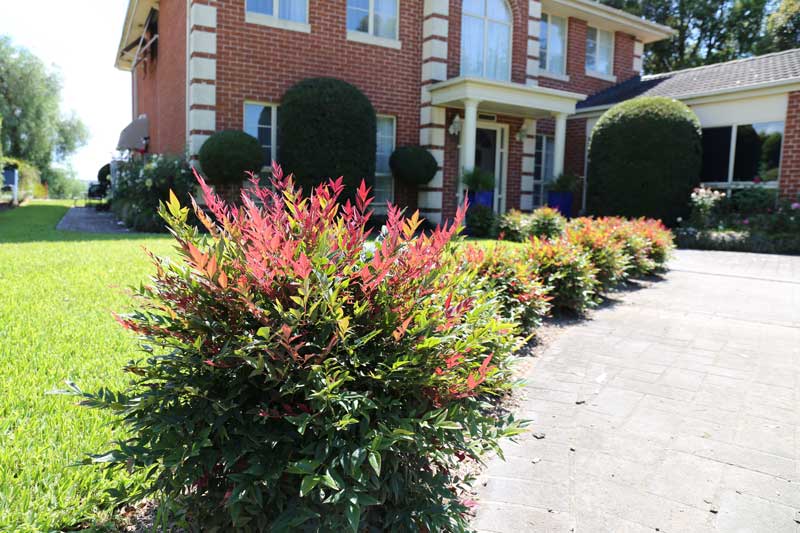
https://ozbreed.co.nz/plant-ranges/shrubs-and-ground-covers/obsession-nandina/
Just Right™ Liriope muscari
Just Right™ Liriope is an evergreen, uniform, and compact plant ideal for planting along borders. It is more evergreen than the Evergreen Giant cultivar and burns less in frost and sun. Additionally, it is tolerant of both drought and wet feet and rarely produces viable seeds.
Size
This liriope grows to 50 cm in height and width. The recommended planting density is 4-9 plants per square metre or 2-4 plants per linear metre.
Climate Tolerance
Just Right™ liriope thrives in full sun to heavy shade and tolerates heat, frost, and a range of soil types from sandy to clay. It requires regular watering for the first 8-13 weeks until established and benefits from being planted in well-mulched gardens.
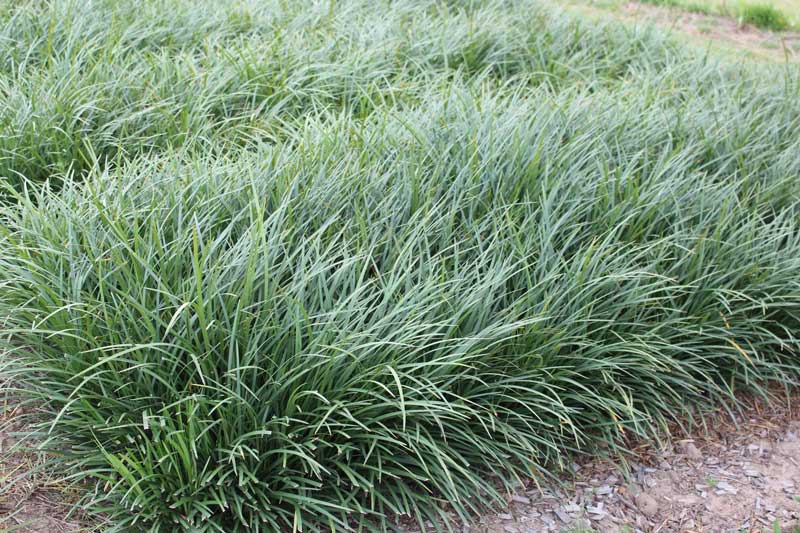
https://ozbreed.co.nz/plant-ranges/strappy-leaf-plants/just-right-liriope/
Conclusion
Specifying plants for lining the borders of pathways and paved areas involves a thoughtful blend of aesthetic vision and practical considerations. By carefully evaluating factors such as climate suitability, light requirements, soil conditions, and traffic tolerance, you can create a beautiful and functional paved garden. With the right choices, your garden will not only look stunning but also support local biodiversity and sustainability. Happy gardening!
